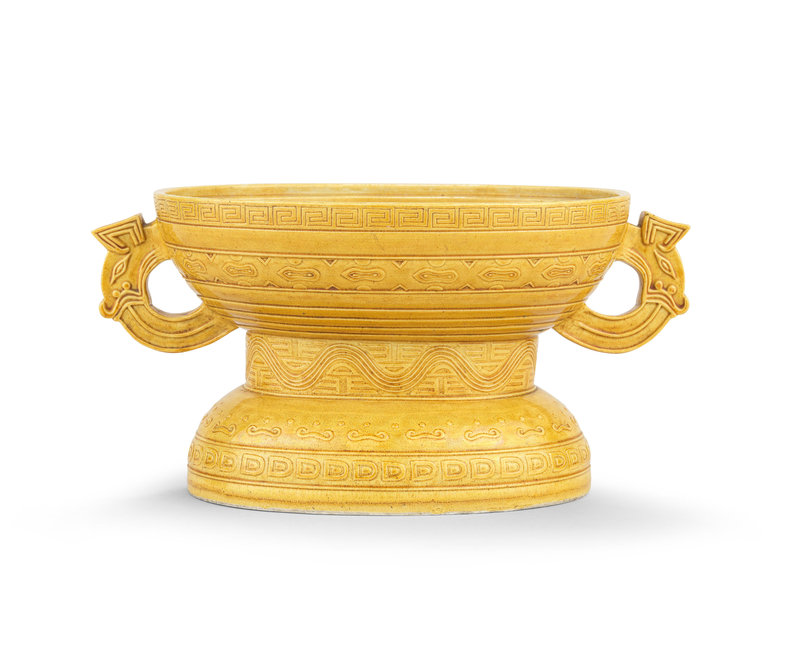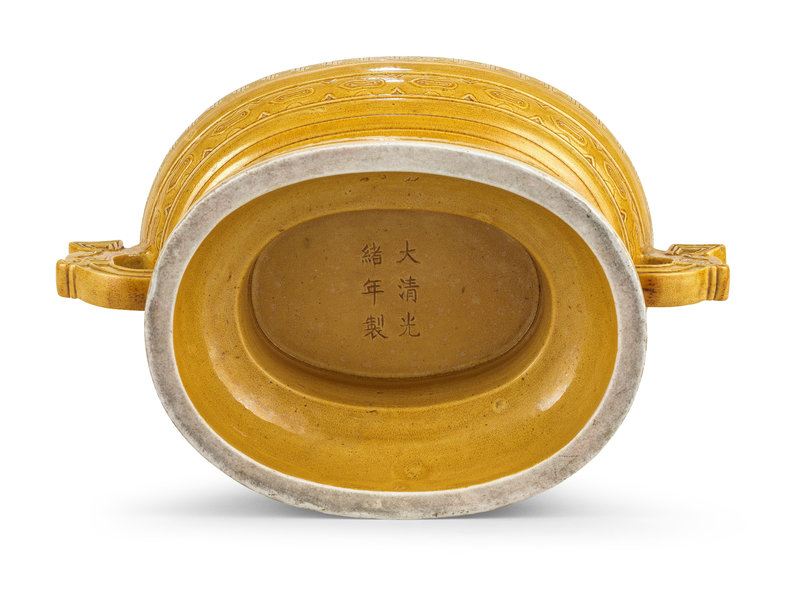Qing dynasty Monochrome sold at Bonhams Paris, 13 December 2023
Lot 37. A rare blue-glazed saucer dish, Kangxi six-character mark and of the period (1662-1722); 17cm diam. Sold for €5,376. © Bonhams 2001-2024
The rounded sides resting on a tapered foot, covered overall inside and out with a rich blue glaze thinning to white over the rim, the base with a six-character mark in underglaze blue within a double circle.
Provenance: Collection of Ernst Ohlmer (1847-1927), Imperial Chinese Maritime Customs Officer between 1887 and 1914
Lempertz, Cologne, 12 December 2009, lot 261.
Published: Daniel Suebsman and Daniela Antonin, Porzellanschätze der Kangxi Zeit - Porcelain Treasures of the Kangxi Period, Düsseldorf, 2015, cat.no.36.
Exhibited: 'Kangxi - Porcelain Treasures of the Kangxi Period', Hetjens Museum, Düsseldorf, June 2015-February 2016, no.36.
Lot 40. A rare yellow-glazed incised saucer dish, Yongzheng six-character mark and of the period (1723-1735); 14.8cm diam. Sold for €7,680. © Bonhams 2001-2024
Finely potted with gently rounded sides, the exterior finely incised with a continuous frieze of leafy, foliate meander bearing eight chrysanthemum flowers alternating with lotus flowers, between single line borders, covered entirely with a thin glaze of vibrant egg-yolk yellow tone, the base with a six-character mark in underglaze blue within a double circle.
Provenance: Lempertz, Cologne, 13 June 1986.
Note: A similar Yongzheng-marked dish incised with floral scrolls, is illustrated in Shimmering Colours. Monochromes of the Yuan to Qing Periods: The Zhuyuetang Collection, Hong Kong, 2005, p.203, no.127. Compare also with a yellow-glazed and incised dish bearing a Yongzheng mark, sold Christie's New York, 3 June 1993 lot 245.
Lot 46. A rare copper-red glazed bowl, lianzi wan, Qianlong six character seal mark and of the period (1736-1795); 15cm diam. Sold for €11,520. © Bonhams 2001-2024
With deep sides rising from a slightly tapered foot, the exterior covered with a copper red glaze thinning to a speckle, pale celadon tone in the upper half of the exterior, the interior and base glazed white, the base inscribed with a six-character seal mark in underglaze blue.
Provenance: China Bohlken, Berlin
Collection of Dr. Ulrich Lindemann, Berlin, purchased 8 June 1970 from China Bohlken, Berlin.
Note: A similar example is illustrated in John Ayers, Chinese Porcelain: The S. C. Ko Tianminlou Collection, Hong Kong, 1987, pl.126. Compare also a similar pair of bowls from the Rodriguez Collection, sold Christie's New York, 20 September 2005, lot 286. A bowl with a similarly distinctive glaze was sold in Christie's New York, 16 September 2016, lot 1359.
Lot 47. A copper-red glazed saucer dish, Qianlong six character seal mark and of the period (1736-1795); 20.8cm diam. Sold for €7,040. © Bonhams 2001-2024
With gently rounded sides rising to a slightly flared rim, covered overall with a glaze of even red tone thinning to white across the rim, the base with a six-character seal mark in underglaze blue.
Provenance: Koller, Zürich, 14 November 1987, lot 425
Lot 39. A white-glazed mallow-shaped wine cup, 18th century; 9.2cm diam. Sold for €3,840. © Bonhams 2001-2024
Delicately modelled with deep, thinly potted sides carved and finely incised on the exterior with a wide band of petals rising to the slightly flared rim radiating from a narrower band of petals with raised outlines around the foot, covered overall with a soft milky-white glaze, the base inscribed in underglaze blue with an apocryphal six-character Chenghua mark in underglaze blue within a double-circle.
Provenance: Christie's London, 17 June 1992, lot 467
An Austrian Private Collection
Lempertz, Cologne, 11 June 2016, lot 199.
Note: A white-glazed cup of similar form with Yongzheng mark from the Kempe collection, is illustrated in Bo Gyllensvard, Chinese Ceramics in the Carl Kempe Collection, Stockholm, 1964, pl.747. Compare also with another white-glazed cups from the collection of Paul and Helen Bernat, sold Christie's New York, 2 December 1993, lot 325. A pair of cups of this pattern size is illustrated in Jan Wirgin, Chinese Ceramics from the Axel and Nora Lundgren Bequest, Stockholm, 1978, pl.74.
Lot 43. A rare robins-egg-glazed beehive waterpot, taibo zun, 18th-19th century; 12.7cm diam. Sold for €5,120. © Bonhams 2001-2024
The hemispherical body rising to a narrow waisted neck below a flared rim, applied overall with a vibrant turquoise-blue glaze of robin's egg type suffused with finely mottled lavender and dark blue streaks, also covering the base.
Provenance: Sotheby's Hong Kong, 29 November 1977, lot 80
Collection of Gudrun and Peter Selinka (1924-2006) (by repute).
Note: Beehive waterpots of this shape are well-known with peachbloom glazes but those covered in other monochrome glazes were produced in smaller numbers. Robin's-egg blue glazes are typically opaque turquoise with overall purplish mottling and are thought to have first developed during the Yongzheng period as an interpretation of Song dynasty Jun glazes. Rose Kerr notes that while visual examination reveals there to be two distinctive types of robin's-egg glaze, one streaked with copper-red and the other stippled with blotches of turquoise and dark blue, further analysis is required to clarify the chemistry of these glazes, see Rose Kerr, Chinese Ceramics. Porcelain of the Qing dynasty, London, 1986, p.88.
Lot 49. A brown-glazed pear-shaped vase, yuhuchunping, Daoguang six-character seal mark and of the period (1821-1850); 30cm diam. Sold for €20,480. © Bonhams 2001-2024
Sturdily potted, the pear-shaped body rising from a splayed foot to a narrow waisted neck and flared mouth, covered on the exterior with an even brownish liver-red glaze, the interior and base glazed white, the base a six-character seal mark in underglaze blue.
Provenance: Sotheby's, Hongkong, 17 November 1975, lot 157.
Note: Compare a similar vase, sold Christie's Hong Kong, 1 December 2010, lot 2972.
Lot 44. A gilt-decorated powder-blue vase, yuhuchunping, Guangxu seal mark and of the period (1875-1908); 29.5cm diam. Sold for €23,040. © Bonhams 2001-2024
The pear-shaped body rising from a straight foot to a waisted neck flaring at the rim, covered overall with a brilliant blue glaze and finely painted in gold around the body with a sinuous five-clawed dragon in pursuit of a flaming pearl and a phoenix with five tail feathers, all amidst blistery clouds, with a band of upright lappets around the base and a band of ruyi heads around the rim, the base with a six-character mark in underglaze blue.
Provenance: Acquired by the secretary to the French ambassador to Shanghai in the 1940s, and thence by descent in the family to the present owner.
Lot 69. A yellow-glazed archaistic ritual food vessel, gui, Guangxu seal mark and of the period (1875-1908); 29cm wide across the handles. Sold for €6,400. © Bonhams 2001-2024
Inspired by the archaic bronze type, the vessel of oblong form with a pair of loop handles surmounted by dragon heads, molded in relief with various bands of archaistic motifs, all covered with a rich mustard-yellow glaze, the base with incised Guangxu six-character mark.
Note: Vessels such as this archaistic vessel, gui, would have been part of a ritual altar set made for the Altar of Earth and would have comprised also a pair of dou, fu and xing-shaped vessels. Similarly-composed sets with archaistic designs would have been made in claire-de-lune, blue and red for ritual use in the Altars of the Moon, Heaven and Sun, respectively. For a related set of Qianlong date with a clair-de-lune glaze from the Palace Museum, Beijing, see Evelyn S. Rawski and Jessica Rawson, China: The Three Emperors, 1662- 1795, London, 2005, pp.125 and 396-397, pls.34-37. For a similar gui and cover in cobalt glaze with impressed six-character Guangxu mark on the base, illustrated in Imperial Porcelain of Late Qing from the Kwan Collection, Hong Kong, 1983, no.144. See also the yellow glazed gui and cover identical to this lot sold in Christie's New York, 22-23 March 2012, lot 2109.
Lot 70. A pair of white-glazed archaistic ritual vessels and covers, dou, Guangxu seal mark and of the period (1875-1908); Each 25.6cm high. (4).. Sold for €30,720. © Bonhams 2001-2024
Each with a deep bowl raised on a spreading pedestal foot and moulded with bands of various archaistic motifs, the domed covers moulded with a network band at the rim and a ruyi collar below the knop finial, covered inside and out with a white glaze of very slight bluish tone, the six-character mark incised in a line inside the foot.
Provenance: Formerly in the collection of Georg Weishaupt (1906-2004), Berlin (by repute).
Note: Compare with another pair of archaistic vessels with Qianlong marks from the Weishaupt Collection, published in Georg Weishaupt, The Great Fortune. Chinese and Japanese Porcelain of the 19th and 20th Centuries and their Forerunners from the Weishaupt Collection, Stuttgart, 2002, no.88. A single archaic vessel and cover of this type covered with a cobalt-blue glaze was included in the exhibition Imperial Porcelain of the late Qing from the Kwan Collection, Hong Kong, 1983, cat. no.147. Compare also with a very similar white-glazed dou vessel bearing a Guangxu mark, sold Christie's New York, 18 and 19 September 2014, lot 924.
Bonhams. CHINESE ART, Paris, 13 December 2023

/https%3A%2F%2Fprofilepics.canalblog.com%2Fprofilepics%2F1%2F0%2F100183.jpg)
/https%3A%2F%2Fstorage.canalblog.com%2F03%2F02%2F119589%2F96711876_o.jpg)
/https%3A%2F%2Fstorage.canalblog.com%2F11%2F31%2F119589%2F94773502_o.jpg)
/https%3A%2F%2Fstorage.canalblog.com%2F20%2F83%2F119589%2F94772815_o.jpg)
/https%3A%2F%2Fstorage.canalblog.com%2F26%2F72%2F119589%2F75604929_o.jpg)
/https%3A%2F%2Fstorage.canalblog.com%2F59%2F60%2F119589%2F26458628_o.jpg)





























/image%2F1371349%2F20240403%2Fob_ec26e4_2024-nyr-22642-0868-000-an-incised-yel.jpg)
/image%2F1371349%2F20240402%2Fob_c0383b_2024-nyr-22642-0863-000-a-small-incise.jpg)
/image%2F1371349%2F20240401%2Fob_33b758_862-1.jpg)
/http%3A%2F%2Fstorage.canalblog.com%2F37%2F19%2F119589%2F129325429_o.jpg)